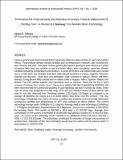| dc.description.abstract | Various genetic and environmental factors adversely affect the yield of beans in East and southern Africa.These include climate change variables such as temperature,moisture,pests, diseases and soils.This paper reviews genetically superior genotypes with reference to yields of various bean lines and varieties in east and South Africa.Also considered were two climatic variables including: temperatures and moisture.A series of on-farm and station trials were carried out to screen lines and varieties from five international nurseries in Kenya,Uganda,Tanzania,Rwanda and Burundi.Sixty four (64) genotypes were screened in Nakuru,Bomet and Meru districts.Using farmer field schools and on station trials in Kaguru-Meru,Egerton-Nakuru and Bomet.The trial yielded superior bean genotypes such as Ciankui,Tasha and the EU a word winning Chelelang “the wonder bean”.These germ plasms had been inspected by KEPHIS and were recommended for commercial growing in cool highlands and warm humid arid- lands.These were the areas with temperatures in the range of 22-30oc and moisture levels of about 400mm per year.It was also observed that Chelelang yielded 1750 Kg/ha(19.5bags) as compared to an average of 550kf/ha (6.0 bags) (i.e 3.19 times better) than Rose coco the control.The new technology (Chelalang) was a bean of choice to replace low yielding environmentally vulnerable commercial varieties and temperatures of 300C and moistures of about 400mm.The current technology average yield =550kg/ha=6.11 bags/ha.Average yield of new technology (Chelalang) = 1750kg/ha=19,4bags/ha. bags/ha/season=38.9 bags/year.Kenya has a potential of 800,000ha for growing beans. This results to 800,000 x 38.9 bags =31,120,000 bags.Average bean consumption in the country is estimated at 26,666,666 bags giving a surplus of =4,453,333 bags. /year.At a price of ksh.4000/bag would translate to an additional revenue of Ksh.4,453,333 x 4000 =17,613,333,333/year.The technology contributed to reduction of hunger and provision of proteins bean. Adoption of this new technology would save the nation a lot of revenue which is appropriate for VISION 2030. | en_US |

